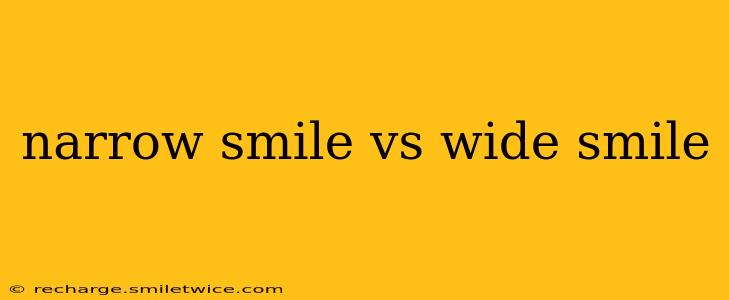A smile—a simple expression, yet incredibly complex in its nuances. From the subtle upturn of the lips to a broad, beaming grin, smiles communicate a vast range of emotions and intentions. Understanding the difference between a narrow smile and a wide smile can unlock deeper insights into human communication and even our own emotional landscape. This article delves into the subtle yet significant distinctions, exploring the psychology and body language behind each type of smile.
What is a Narrow Smile?
A narrow smile, also sometimes referred to as a "lip corner pull," involves only a slight elevation of the corners of the mouth. The lips may remain relatively closed, and the expression often appears reserved or controlled. Unlike a wide smile, which engages more facial muscles, a narrow smile usually lacks the crinkling around the eyes often associated with genuine happiness.
Key characteristics of a narrow smile:
- Minimal lip movement: The corners of the mouth lift only slightly.
- Lack of eye engagement: The eyes usually remain relatively still, lacking the crinkles associated with genuine amusement or joy.
- Controlled expression: It often appears more restrained and less spontaneous than a wide smile.
What is a Wide Smile?
A wide smile, in contrast, is a much more expansive expression. It involves a significant elevation of the lips, revealing teeth and often accompanied by the crinkling of the eyes—a key indicator of authenticity (Duchenne smile). A wide smile typically signifies genuine happiness, joy, and openness.
Key characteristics of a wide smile:
- Significant lip elevation: The lips are lifted considerably, often revealing teeth.
- Eye engagement (Duchenne smile): The muscles around the eyes contract, creating characteristic wrinkles (crow's feet). This is a crucial sign of genuine emotion.
- Spontaneous expression: Wide smiles usually appear more natural and less contrived than narrow smiles.
What Does a Narrow Smile Mean?
The meaning behind a narrow smile is highly contextual. While it can sometimes indicate politeness or forced pleasantries, it can also signify discomfort, uncertainty, or even deception. The surrounding body language and the situation are crucial for proper interpretation.
Possible interpretations of a narrow smile:
- Politeness: A subtle smile offered as a social nicety.
- Discomfort: A nervous or uneasy smile, masking underlying apprehension.
- Subdued emotion: A restrained expression of happiness or amusement.
- Concealment: A smile used to hide negative emotions or intentions.
What Does a Wide Smile Mean?
A wide smile, especially a Duchenne smile, typically conveys genuine positive emotion. It signals happiness, joy, contentment, and openness. The presence of the eye crinkles reinforces the authenticity of the emotion being expressed.
Possible interpretations of a wide smile:
- Genuine happiness: Unfiltered joy and contentment.
- Enthusiasm: Excited and positive engagement.
- Approachability: A welcoming and friendly expression.
- Connection: A signal of bonding and positive interaction.
How Can I Tell the Difference? Observe the Eyes!
The most reliable way to distinguish between a narrow smile and a wide smile is to observe the eyes. The presence or absence of crow's feet around the eyes is a significant indicator. A Duchenne smile, with its eye crinkles, signifies genuine emotion, whereas a narrow smile without eye engagement might suggest a more superficial or controlled expression.
Can Body Language Help Decipher the Meaning?
Absolutely! Consider the overall body language accompanying the smile. Is the person relaxed and open, or tense and closed off? Are their shoulders slumped, or are they held high? These cues can greatly influence the interpretation of the smile's meaning. For example, a narrow smile coupled with crossed arms and averted gaze might signal discomfort or distrust, whereas a wide smile accompanied by open posture and direct eye contact suggests genuine warmth and approachability.
Are There Cultural Differences in Smile Interpretation?
Yes, cultural norms can influence both the display and interpretation of smiles. What might be considered a polite smile in one culture could be perceived as insincere or even hostile in another. Understanding the cultural context is essential for accurate interpretation.
This exploration into the nuances of smiles provides a deeper understanding of nonverbal communication. Remember, context is key; paying close attention to the entire expression, body language, and surrounding situation is crucial for accurate interpretation. By recognizing the subtle distinctions between a narrow smile and a wide smile, we can better navigate the complexities of human interaction.
